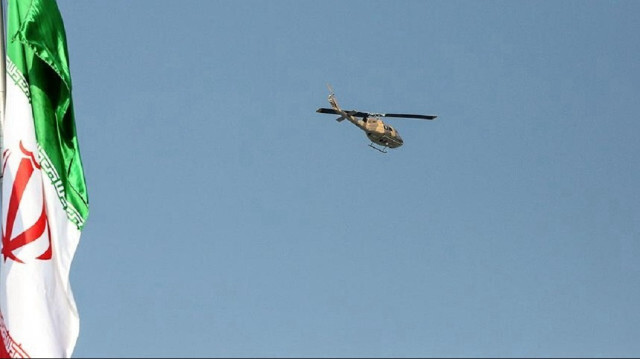
Iran's ageing helicopter fleet was pushed into the spotlight after a crash last week claimed the lives of President Ebrahim Raisi, Foreign Minister Hossein Amir-Abdollahian, and seven others.
Anadolu correspondent compiled the information about the condition and maintenance of the helicopters in Iran's military inventory.
The decades-old fleet comprising various models all procured before the 1979 Islamic Revolution reportedly faces significant maintenance and parts supply challenges due to prolonged international sanctions. These issues have severely affected their operability, leaving the exact number of functional airframes unclear.
- US-made helicopters
A substantial portion of Iran's helicopter fleet consists of American-made choppers, including Sikorsky SH-3 Sea Kings, RH-53D Sea Stallions, Boeing CH-47 Chinooks, and various Bell models. These helicopters were acquired before the 1979 revolution.
Iran operates eight Sikorsky SH-3 Sea Kings, initially designed for anti-submarine warfare but later adapted for VIP transport.
The country's Supreme Leader Ayatollah Ali Khamenei rarely uses helicopters, preferring airplanes even for short domestic trips despite having a fleet capable of VIP transport.
These helicopters were used by the US Navy from 1961 to 2006 when they were eventually retired.
Iran also possesses several RH-53D Sea Stallions, primarily obtained for naval mine-laying tasks.
The helicopter made its first flight in 1964 and entered service in 1966, before being retired from active duty in 2020.
The tandem-rotor Boeing CH-47 Chinook, known for its heavy-lift capabilities, also features prominently in the Iranian fleet.
Iran received over 100 Chinooks from the US before the revolution but several were lost during the Iran-Iraq War in the 1980s.
Additionally, models like the Bell 206, Bell 212, and Bell 214 are part of Iran's inventory, though their operational status remains uncertain due to maintenance challenges. A Bell 212 was carrying President Raisi and his entourage.
The Iranian army currently has 32 Bell 212s and Bell 214s.
Iran has two Bell 412 helicopters, an improved version of the Bell 212 that made its first flight in 1979.
Finally, Iran holds 12 US-built Kaman HH-43 Huskie helicopters, which initially flew in 1953 and were retired in the 1970s. There is no evidence as to whether Tehran actively uses them.
- Russian-made helicopters
The Iranian fleet also features several models of Russian-made helicopters, including the Mil Mi-8/17, known for its versatility and a popular choice in military transport.
Iran is thought to have at least five Mi-17 model helicopters, a staple in many military fleets worldwide. It is capable of various roles, including cargo transport and armed missions.
First designed in the 1960s, the Mil Mi-17 entered service in 1975 and is still in production.
Russia delivered approximately 21 Mil Mi-171S helicopters, a modern version of Mi-17, to Iran in 1999-2001, but the exact number is unknown.
- Attack helicopters
The majority of Iran's attack helicopter fleet consists of US Bell AH-1 SuperCobra. It made its first flight in 1969 and was retired by the US in 2020.
The 202 helicopters in Iran's inventory are known as AH-1J International. It is believed that some of these helicopters were lost during the Iran-Iraq War. Iran claims it can produce the helicopter with domestic capabilities.
Iran also operates Russian Mil Mi-24s, a robust attack helicopter with considerable firepower and protective armor.
The helicopter has been produced since 1972 and is currently used by 50 countries. Iran's actual fleet size for the Mil Mi-24 is unknown.
Recently, Iran confirmed acquiring Russian Mi-28 attack helicopters, known for their combat capabilities. Additionally, plans for joint production of Mi-28 and Ka-52 attack helicopters in Iran have been announced.
- Recent acquisitions and local production
Iran has taken steps to locally produce and modify existing helicopter models in response to sanctions and the resulting parts shortage.
The Shabaviz 206-1 is a reverse-engineered version of the Augusta-Bell AB-206 and the Shabaviz 2-75 is an Iranian production model of the Bell 214C. Both helicopters are facing patent lawsuits filed in the US.
Iran has also developed a light helicopter similar to the Bell 206, the Shahid-278, which is a combination of several helicopters.
The Saba-248, which Iran put into service in 2016-2017, is a twin-engine, four-wing general-purpose helicopter, similar in appearance to choppers like the AgustaWestland AW119 and Bell 427.
Iran has also re-engineered its AH-1J Cobra helicopters, which were taken out of service in 1999 due to spare parts shortage, using domestic facilities and named them PANHA 209-1.
These helicopters now feature reinforced armor, radar, and infrared systems, and are capable of firing anti-tank guided missiles.
The Shahid-285, which was introduced in May 2009, is claimed to be a state-of-the-art attack helicopter that can be used in naval and air combat.














